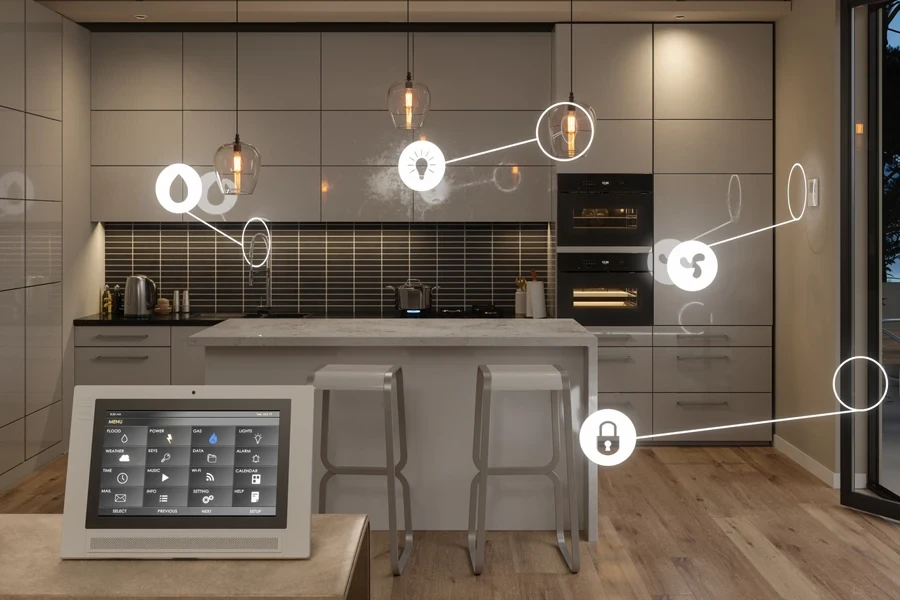Do consumers want to reduce their energy bills or make their lives more convenient? Home automation systems have a lot to offer in that regard. However, for anyone setting up smart features like lighting, security sensors, or door locks, it’s important that all their devices can connect and work together smoothly.
That’s where communication protocols like Zigbee come in—they help smart devices “talk” to each other through one system. This article will cover everything you need to know about Zigbee, including how it works and why it could be a smart addition to one’s home setup in 2025.
Table of Contents
What is Zigbee?
How does Zigbee work?
A quick history of Zigbee
Zigbee vs. Z-wave: What are the differences?
3 tips to consider when choosing Zigbee over other wireless technologies
1. Learn more about Zigbee’s wireless security
2. Consider protocol compatibility
3. Check if it has the Over-the-Air (OTA) software upgrade feature
Is Zigbee better than Wi-Fi?
Rounding up
What is Zigbee?

Zigbee is a type of wireless technology that helps smart home devices communicate easily. It’s common in home automation to connect things like smart door locks, thermostats, lights, and bulbs. It ensures that everything works together well without needing a bunch of separate apps or complicated setups.
When Zigbee is up and running, it allows smart devices to share small bits of information without consuming too much power. Since smart devices are always sending tiny updates (like a motion sensor detecting movement or a door lock checking in), having a system like Zigbee is important to keep everything connected while using very little energy—one of the reasons why people love it for smart homes.
How does Zigbee work?
Before consumers set up a Zigbee device, they’ll need a compatible smart home hub. This hub creates the Zigbee network, which links all their smart devices together so they can communicate and work as a team. One cool thing about Zigbee is that it uses a peer-to-peer connection, meaning all devices don’t have to be close to the Wi-Fi router to stay connected.
They can pass signals between each other, like a chain, which helps keep everything smooth throughout the home. For example, consumers may place their Zigbee hub in their main bedroom, but they may have smart lights installed on the opposite side of the house.
In such situations, those lights may be too far away to connect directly to the hub. The good news is that they won’t need to buy another hub. With Zigbee, it can still connect as long as the smart light is within range of another Zigbee device (like a smart plug or switch).
How? Zigbee creates a mesh network where every device helps pass the signal along. It’s like a relay team that ensures the smart home stays connected, even in a bigger space.
A quick history of Zigbee
The concept of low-power, wireless mesh networks began in the 1990s. However, it wasn’t until the early 2000s that the Zigbee Alliance debuted by creating the Zigbee protocol based on the IEEE 802.15.4 standard. Over time, Zigbee continued to evolve.
In 2006, the original setup received a major upgrade with a “cluster library,” which made it easier for devices to talk to each other. Then, in 2007, Zigbee Pro entered the spotlight with a new feature that allowed some devices to power themselves using energy from their surroundings—like light or motion.
Fast-forward to 2021, when the Zigbee Alliance changed its name to the Connectivity Standards Alliance (CSA) to reflect its growing role in developing other smart home technologies, not just Zigbee.
Zigbee vs. Z-wave: What are the differences?

We’ve talked a lot about Zigbee, but how does it compare to Z-wave? Z-wave is another popular option for smart homes. However, one of the biggest differences is that it works on the 908MHz frequency band instead of the 2.4 GHz common with Zigbee devices. The big benefit is that this frequency band helps the protocol avoid interruptions from other common signals, like Wi-Fi.
But there’s more. While Zigbe can reach up to 250 feet or more (thanks to devices extending its range), Z-wave usually reaches from 30 to 100 feet, depending on the home’s layout. Although Z-wave also works on a mesh network, it can only support up to 232 devices—a far cry from Zigbee’s 65,000.
In short, Zigbee can handle more devices and has more global support, while Z-Wave may offer a simpler, more interference-free setup, especially in crowded wireless environments.
3 tips to consider when choosing Zigbee over other wireless technologies
1. Consider protocol compatibility

One great thing about the Zigbee protocol is its forward and backward compatibility. Hence, the connection always works whether the Zigbee devices are new or old. So, even if consumers want to upgrade, they won’t have to change everything to use their new network.
Zigbee is also compatible with many popular brands, including Samsung SmartThings, Amazon Echo Plus & Echo Show, Belkin WeMO, Philips Hue lights, and Yale smart locks. Even better, most brands ensure their devices can support Zigbee’s latest features, so users won’t have to worry about different products not working.
2. Learn more about Zigbee’s wireless security

Zigbee will be moving a lot of data (some sensitive) back and forth, so it’s normal for consumers to be worried about security. The good news is that Zigbee does not fall behind in security.
The smart home protocol comes with strong encryption based on 128-bit keys and AES. Bad parties cannot access the network, as these technologies are among the best for securing sensitive information.
If consumers are not convinced yet, Zigbee applies this security at different system levels (like the Application, Network, and MAC layers). For this reason, data will always be secure during transfer. Plus, the newer Zigbee Pro 2023 has even better security, so consumers have nothing to worry about.
3. Check if it has the Over-the-Air (OTA) software upgrade feature

Here’s something important to always look for: Zigbee’s Over-the-Air (OTA) updates. This feature ensures updates can move from one Zigbee device (usually the hub) to other devices on the network without needing a manual install. This means that manufacturers can send improvements, security boosts, bug fixes, or new features, and all Zigbee devices will get a piece of the update.
Is Zigbee better than Wi-Fi?
Another common question customers ask is if Zigbee is better than Wi-Fi. The answer is yes, Zigbee is better than Wi-Fi for one good reason: it’s not power-hungry. Wi-Fi doesn’t consume as much power as cellular, but Zigbee needs much less to run.
For this reason, it’s the better choice for smart devices running on batteries. But that’s not all. Zigbee’s connection style also makes it superior to Wi-Fi. Since it runs on a mesh network, everything will keep working even if one connection point or device fails—which is not the same for Wi-Fi.
Rounding up
Thanks to the Zigbee Alliance (now CSA), Zigbee stays highly compatible. They set standards that ensure wireless communication between devices is secure, reliable, and energy-efficient. For this reason, Zigbee devices from different brands can connect and function smoothly within the same system.
Overall, Zigbee is a strong, flexible protocol that helps keep smart homes connected and running efficiently. If consumers are just starting to build their smart home setup, choosing a protocol like Zigbee makes it easier to add compatible devices later.



